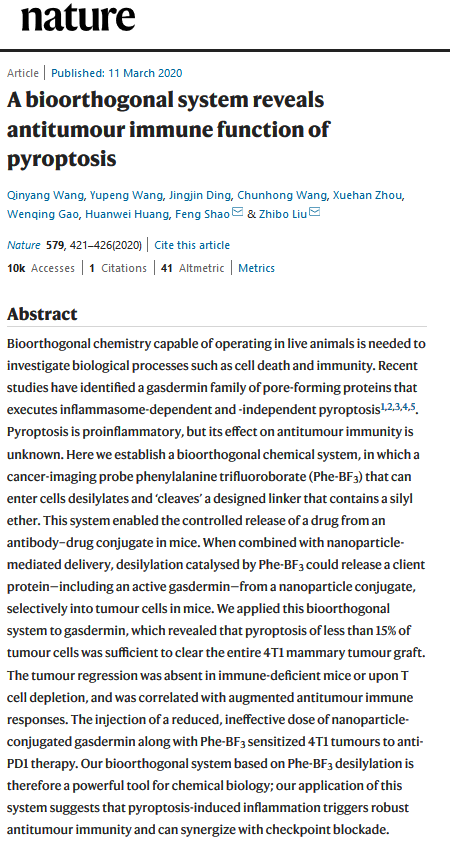20.04.2020
A bioorthogonal system reveals antitumour immune function of pyroptosis
Nature, volume 579
Abstract
Bioorthogonal chemistry capable of operating in live animals is needed to investigate biological processes such as cell death and immunity. Recent studies have identified a gasdermin family of pore-forming proteins that executes inflammasome-dependent and -independent pyroptosis1,2,3,4,5. Pyroptosis is proinflammatory, but its effect on antitumour immunity is unknown. Here we establish a bioorthogonal chemical system, in which a cancer-imaging probe phenylalanine trifluoroborate (Phe-BF3) that can enter cells desilylates and ‘cleaves’ a designed linker that contains a silyl ether. This system enabled the controlled release of a drug from an antibody–drug conjugate in mice. When combined with nanoparticle-mediated delivery, desilylation catalysed by Phe-BF3 could release a client protein—including an active gasdermin—from a nanoparticle conjugate, selectively into tumour cells in mice. We applied this bioorthogonal system to gasdermin, which revealed that pyroptosis of less than 15% of tumour cells was sufficient to clear the entire 4T1 mammary tumour graft. The tumour regression was absent in immune-deficient mice or upon T cell depletion, and was correlated with augmented antitumour immune responses. The injection of a reduced, ineffective dose of nanoparticle-conjugated gasdermin along with Phe-BF3 sensitized 4T1 tumours to anti-PD1 therapy. Our bioorthogonal system based on Phe-BF3 desilylation is therefore a powerful tool for chemical biology; our application of this system suggests that pyroptosis-induced inflammation triggers robust antitumour immunity and can synergize with checkpoint blockade.
The following product was used in this study:
GTX74034 IL1 beta antibody


